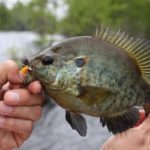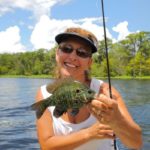
It might be a bit early for bream to turn on full force, but April is when chinquapin begin to gang up for the spawn. And there’s no better place to catch them than the Atchafalaya Basin’s Flat Lake.
It’s easy. It’s fun. It can be “flat-tastic!” Ask anyone in the tri-city area of Morgan City, Berwick and Patterson where is the best place to fish redear sunfish, fondly referred around these parts as chinquapins, and the first place they’ll tell you is Flat Lake. What’s more, the month of April is when it turns on.
Akaloy Paul spends much of his time making his living cutting meat for Rouses Supermarket between Thibodaux and his home in Patterson. In his spare time, he fishes bass competitively.
But when Paul isn’t putting weight on the scale, the tournament angler sneaks out to Flat Lake to fish chinquapins.
“We’ll usually fish them in April,” said Paul, who’ll take his wife Phyllis on trips into the Atchafalaya Basin for the panfish action. “It doesn’t take all of the effort and finesse bass fishing does. And it starts to get really good in April, especially when you get on a good bed of them during that first spawn. It’s usually the prime time.
“Bass are coming off the spawn, and chinquapins will start laying and they get up into that grass in Flat Lake to do their thing.”
Louisiana Department of Wildlife & Fisheries biologist Brac Salyers said Flat Lake’s excellent fishing is because of the habitat Paul refers to.
“Flat Lake provides good fishing for redear sunfish because it is ideal spawning habitat, with slow-moving backwaters containing sandy to soft mud bottoms and abundant aquatic vegetation for cover and food sources,” Salyers said. “The time period between April through June is basically the peak of their spawning, and being community spawners, they likely congregate there during that time period.”
Bass anglers along the coast usually see bass starting to stage in late February and early March provided the weather cooperates and the water temperature is right. Generally somewhere between 62 and 70 degrees is when the female bass typically start to spawn.
It isn’t until that water warms slightly more in April, before chinquapins get started.
“Redears or chinquapins can spawn multiple times during the spring and summer months, depending on temperature,” Salyers said. “Literature suggests their ideal range is 69.8 to 89.6 degrees Fahrenheit, with peak spawning occurring at 75 degrees. They can spawn into the early fall if the water temperature stays up, and have done so in studies in Florida, spawning into August.
“There is also some evidence that peaks in spawning activity may correspond with full or new moons.”
Among those who year in and year out fish Flat Lake for chinquapins, there are two schools of thought when targeting these little fighters: Are you going to use artificial baits or fresh bait in the form of worms, crickets or grubs?
Paul, being a bass angler, predictably prefers artificial baits when it comes to hooking redears — but with a little fresh bait enticement.
“I won’t fish purely an artificial bait,” he said. “The technique I use during the spawn is I’ll take a tube jig or a hair jig and put a little cheater on it — like a piece of worm or Gulp! Nibble.
“I’ll fish using that setup around the cypress trees when I fish Flat Lake, starting where Big Jessie Bayou opens into the lake (and) working my way around the grass beds toward the mouth of Bear Bayou. I’ll also try and fish around any stumps that I can see, too.”
This fishing is, by and large, a cork affair. Every size, shape and color is used. Plastic bobbers, peg floats, snap-on floats and balsa wood are all popular.
But it’s the depth you’re fishing at that counts the most.
“If the water is 3 to 5 feet deep, I’ll normally try to get my bait down where it bumps the bottom and I work my way up,” Paul said. “Chinquapins will come up and get it. I’ll inch my cork up or down until I get to that right depth. And I’ll do that to find out where they’re at.”
When the chinquapin bite turns on in Flat Lake you can fill an ice chest during a day on the water. Salyers said when anglers see that schooling activity during the spring it is related to the spawn. What’s more, being community spawners, their nests may be located very close together — usually in shallow depths of 1 to 6 feet deep, with males constructing and defending the nests from more aggressive bluegills, other sunfish and bass until the eggs hatch.
Youngsville resident Dustin Delino tries to make a trip to Flat Lake each year, using both artificial and fresh bait.
“We’ll use small beetle spins around the cypress trees, but recently when we’ve gone back, the grass has been so thick you couldn’t fish the trees,” Delino said. “So we started fishing out into the lake more, just outside of the grass beds. We’ve used tube jigs, and caught a few around the grass beds right at the mouth of Bear Bayou.”
Fishing that area required some adjustments, however.
“The first thing you’ll notice when you get there is how clear the water is, which made us kind of leery to fish there at first,” he explained. “But, we have set on anchor around 10 feet or so away from the grass and thrown away from the boat with our corks set to around 3 to 4 feet deep. We’ve had good success fishing this way each time we go.
“We’ll just use cold worms around the grass beds with a simple worm hook — nothing special.”
On any given morning, it’s possible to see anglers using extra-long poles jigging artificial baits around trees, short ultra-light poles with a cricket or worm under a cork or just their everyday pole they’re used to using.
Delino will switch things up as needed.
“We like to use ultra-light tackle and sometimes a long pole, depending on what kind of area we’re getting into,” Delino said.
But he is fond of the lightest tackle.
“It makes it fun, especially on the bigger ones,” he said. “With the water being so clear, the small ultra-light spinning reel lets us cast a little ways out there.
“We’ve used both crickets and worms, and found we’ve had a little bit better success with worms. I don’t know if it’s just the day or what. But we’ve never gone wrong with worms.”
Paul fondly tells the childhood story about when his parents would take the family fishing and all of the kids would be sent out to pick up whatever they’d find in the yard for bait.
“We’d look under old boards and things like that,” Paul recounted. “We’d pick up worms, crickets, but also those big white grubs with the brown head. Those work good, too, on chinquapins.”
The one thing anglers will notice when heading into Flat Lake is how the river influences the water clarity and that a distinct dividing line runs diagonally across the lake. The southern half of the lake, which is closer to the river, typically is murky to stained in appearance; the north half of the lake where anglers normally head under normal conditions is extremely clear.
“The dividing line in Flat Lake is the separation of the water currents,” Salyers said. “The slower currents that have had time to settle out the sand and sediment will be the clearer water, whereas the stained water is coming from the swamp tributaries or bayous and still contains the tannins from leaves breaking down and likely some sediment.”
“This lake, like the rest of the basin is unfortunately very susceptible to high-water sedimentation rates and will continue to become shallower over time.”
The proximity to the Atchafalaya River also makes it a bit unpredictable.
“The river can also influence the chinquapin spawn by keeping water temperatures lower during high-water years from the upper Mississippi basin snow melts and rainfall resulting in a possible delayed spawn,” Salyers said. “Also, a heavier flow will cause scouring in the river and could flush eggs out of their nest if waters rise quickly during the spawning period.”







